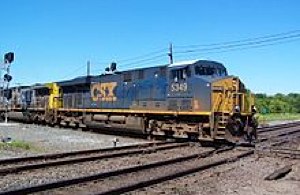 Of all freight transportation options, rail is the most environmentally friendly way to move goods over land, according to the Environmental Protection Agency (EPA), which estimates that for every ton-mile, a typical truck emits roughly three times more nitrogen oxide and particulates than a locomotive.
Of all freight transportation options, rail is the most environmentally friendly way to move goods over land, according to the Environmental Protection Agency (EPA), which estimates that for every ton-mile, a typical truck emits roughly three times more nitrogen oxide and particulates than a locomotive.
If just 10% of the nation’s freight were shifted to rail fuel savings would approach one billion gallons annually.
New energy innovations and green programs at CSX Transportation, one of the major rail lines serving the Eastern half of the US, not only save money for the company but are also conserving fuel and cutting additional carbon emissions.
So far, the private company has invested $2 billion over the last decade to improve its locomotive fuel efficiency with the result that its trains can move one ton of freight nearly 500 miles, on average, with a single gallon of diesel fuel.
1) Locomotive Idling Reduction Technology
To reduce fuel consumption and greenhouse gas emissions during idling along its 21,000 miles of track, CSX has invested in two separate pieces of idle-reducing technology. Auxiliary Power Units provide power to a locomotive, allowing the larger diesel engine to be shut down. The Automated Engine Start Stop acts similarly by automatically shutting down the locomotive when not in use and automatically starting it when needed.
2) New Piloting Technology
A new, real-time energy management technology uses GPS and track data on both grade and curvature to identify the most fuel-efficient throttle settings for each trip as the train moves across the system. In addition, methods of rail lubrication are being explored to reduce rail-to-wheel friction and increase fuel efficiency.
3) Recycling
With zero waste the ultimate goal, CSX is using a variety of materials that are recycled in their day-to-day business. Steel from old locomotives and rail cars is recycled, along with batteries, cross ties, and electronic equipment. Also, millions of gallons of oil annually are recycled, with some being used to heat buildings in certain locations.
4) Hazardous Chemicals Cut From Cleaning Regimen
Cleaners containing chlorinated solvents and low-flash-point mineral spirits are now banned from use on railroads. These cleaners have been replaced with environmentally friendly cleaners, such as 140 Solvent. Oil-based paints are in the process of being replaced with water- based low-VOC paints, which are purchased in 300-gallon reusable totes, reducing packaging associated with paint products.
5) Environmental Crimes Unit
With illegal dumping rampant on railroad properties, CRX has initialed a Police Environmental Crimes Unit to investigate and prosecute offenders. Since the unit’s inception, 1,020 incidents have been investigated, resulting in 52 prosecutions, with a conviction record of nearly 100%.
6) Upgrading Tracks for Double-Decker Freight Cars
In May 2008, CSX Corporation launched the National Gateway, an $842 million public-private infrastructure initiative to beef up the transportation link between the Mid-Atlantic ports and the Midwest. The goal is to provide clearance and tracks for double-stack trains that can carry twice as much cargo and provide significant environmental and efficiency benefits.
The National Gateway leverages the benefits of rail transportation to the fullest by enhancing three existing rail corridors that run through Maryland, Virginia, North Carolina, Pennsylvania, Ohio and West Virginia.
When completed, the National Gateway will significantly benefit the nation by not only cutting fuel use and emissions per ton of freight, but improving safety and highway congestion by maximizing the efficiency of freight rail and partnering with trucking companies to reduce truck miles traveled by more than 14.3 billion miles.
* Increasing economic competitiveness by saving $3.5 billion in shipper and logistics costs, significantly increasing freight capacity, reducing transit times by 24 to 48 hours between West Coast ports and major population centers; and tripling the market access potential for the ports of Baltimore, Hampton Roads and Wilmington;
* Creating more than 50,000 jobs, including more than 25,000 jobs in 14 economically distressed areas (more than 4,000 jobs are to be created by the end of 2012); and
* Repairing and replacing declining infrastructure, replacing older bridges and avoiding more than $670 million in pavement maintenance costs, while requiring no public funding for ongoing maintenance.



















